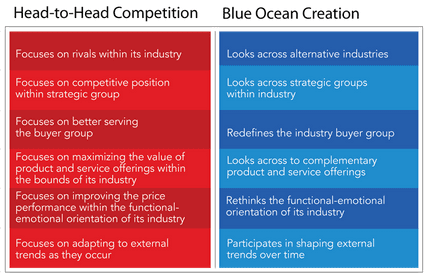

Discover which factors your industry has long competed on that should be eliminated, and explore which factors should be created that the industry has yet offered. For value innovation to occur, however, you need to focus on the big picture, not the numbers. For traditional companies, their key value proposition meets at the intersection of price and product or feature value. The concept of value innovation is crucial to Blue Ocean Strategy. The "search risk" comes from the need to educate your customer base about the new market that's been created. So under this first principle, reconstruct market boundaries, your company could face a "search risk". For instance, Blue Ocean Strategy operates under the belief that boundaries and industry structures can be reconstructed based on the actions of the players involved. Each principle comes with its own set of risks. There are six principles of Blue Ocean Strategy, each with key tools and objectives. Blue Ocean Strategy is the framework to pursue both differentiation and low cost to open a new market with new demands. The study revealed companies that go after markets with high profit potential and less competition are the most successful. Application Introductionīlue Ocean Strategy was conceptualized based on studies of company success and failure in more than 30 industries over 10 years. Instead, dive into a Blue Ocean to create your own market space, with products that align innovation, price, utility, and cost. Competing in a crowded and over-saturated Red Ocean only maintains your status quo, and is probably costly and futile. While "disruption" has become a buzzword, the concept of value innovation is the secret ingredient used by legendary favorites across different industries. Before Uber, no one clicked a button to have a stranger pick them up. Before Apple created iTunes, no one bought individual mp3 tracks over CDs.

Before there was Ford, there was no market for automobiles – because the competition was horses.


 0 kommentar(er)
0 kommentar(er)
